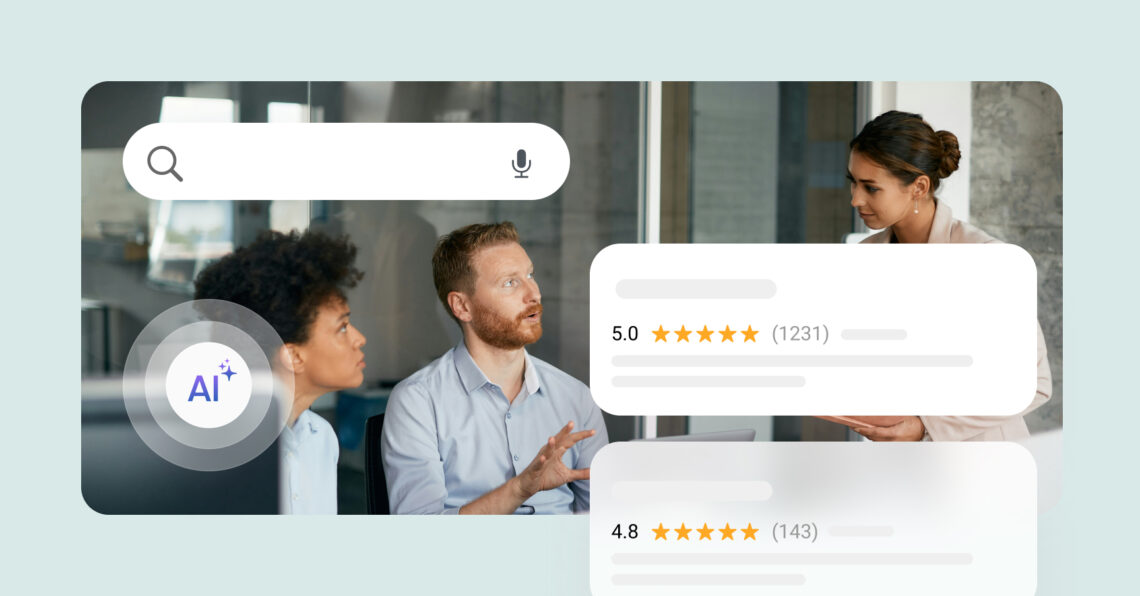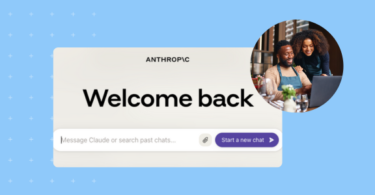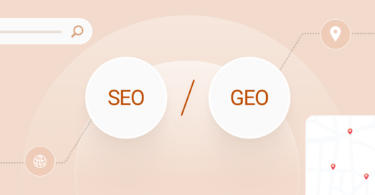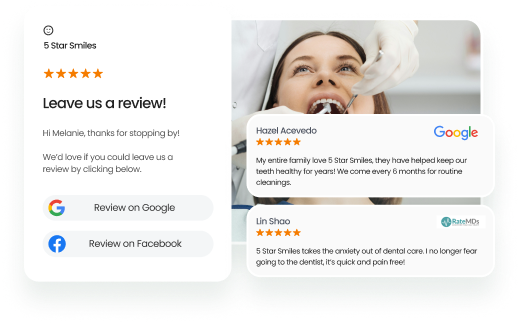The way people discover businesses is changing. AI search tools like ChatGPT, Google’s Gemini, and Perplexity are reshaping how consumers find and engage with local businesses, offering a more conversational and personalized search experience.
These AI tools allow users to ask conversational questions like “Where can I find a good dentist near me?” or “What’s the best Italian restaurant open now?”—a shift from traditional, keyword-based Google searches.
While this shift feels transformative, it’s important to stay grounded. According to SparkToro, Google Search still gets 373 times more queries than ChatGPT, and the gap is even higher when it comes to searches with local intent.
So, how can businesses adapt to AI search without losing focus on proven strategies? This blog explores practical tips to optimize for the future while continuing to use local SEO to stay visible in every type of search.
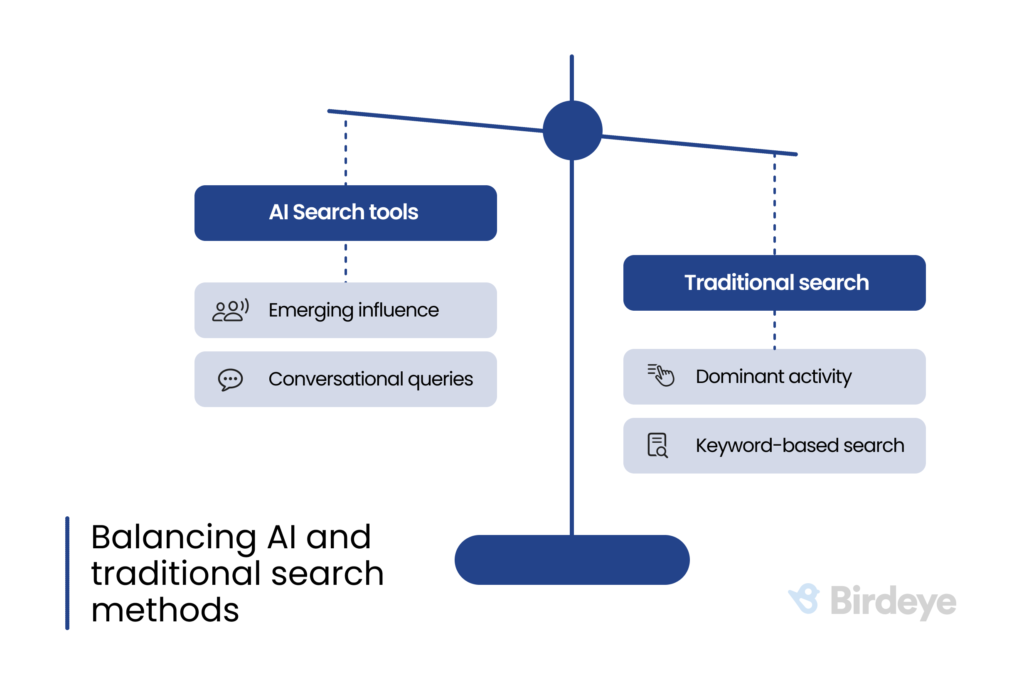
AI search is growing — but traditional search still matters
AI search tools offer a more interactive, conversational way for users to find answers, and their growing influence is hard to ignore. However, their use cases differ fundamentally from traditional search.
For instance, when I searched “best dentist in Dallas, Texas” on Google, ChatGPT, and Perplexity, the top results were similar, but the approach and context varied noticeably.
Google’s result
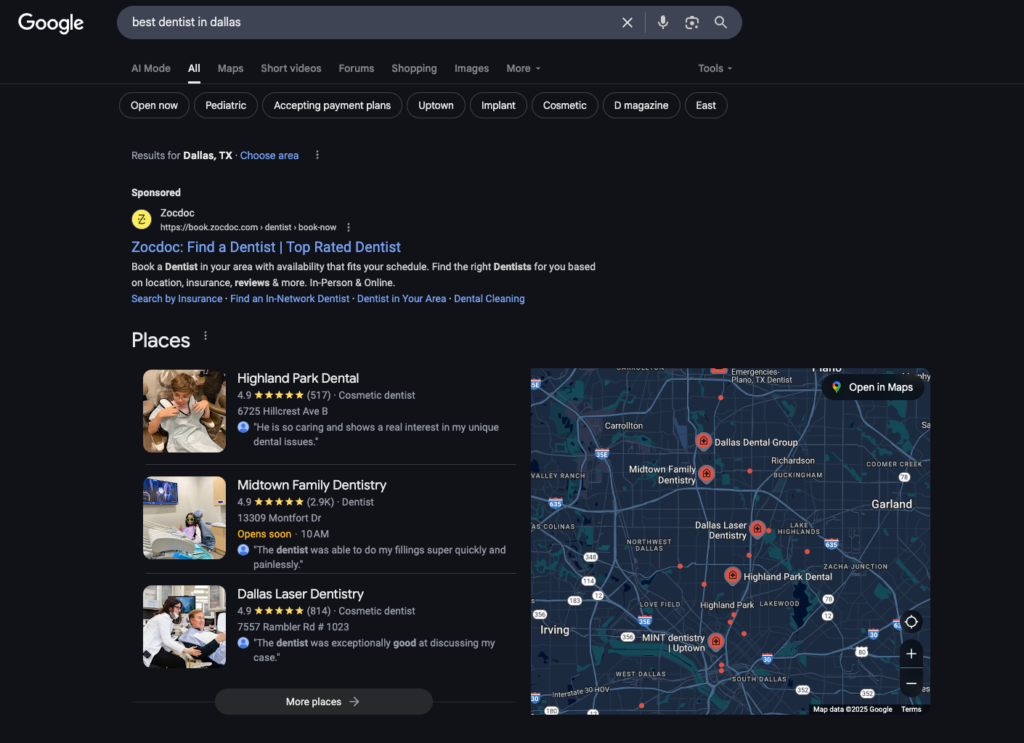
Google offers direct, highly specific listings with actionable details like business ratings, addresses, and call-to-action buttons. It’s practical and based on clear user intent.
Google’s Map results clearly show nearby options, giving users relevant, location-based results that support quick decision-making.
ChatGPT’s result
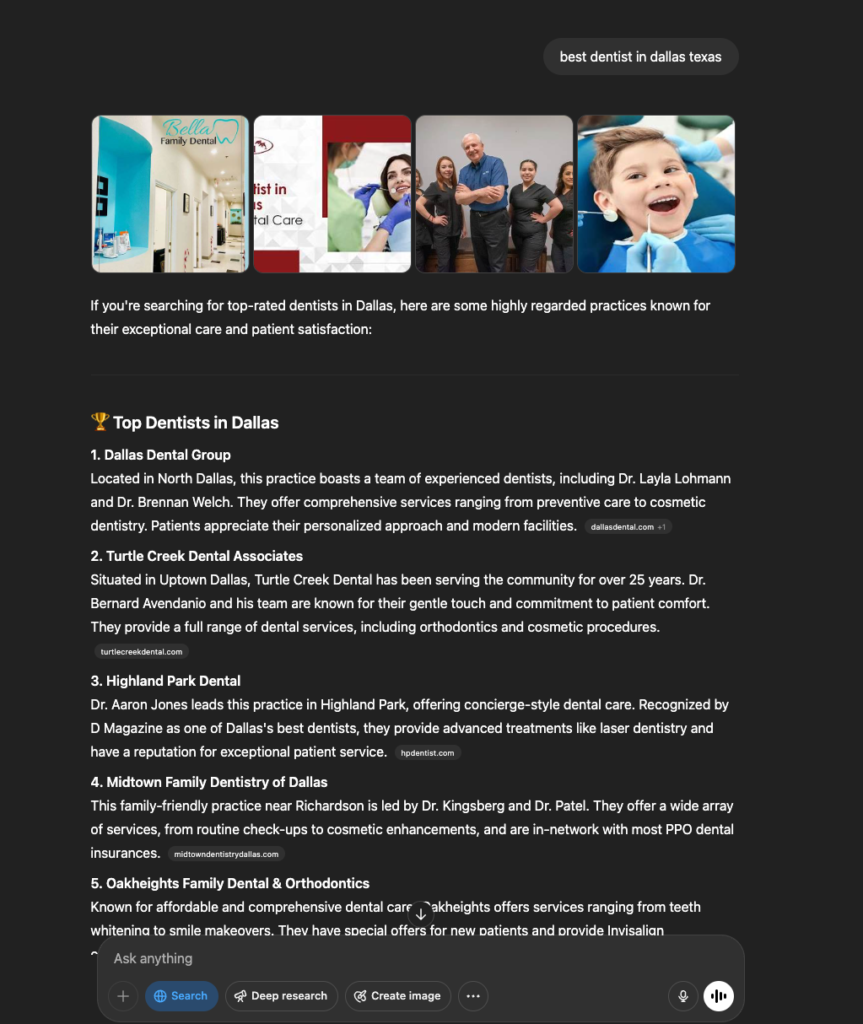
ChatGPT, however, presents a broader context. While it does pull similar businesses as Google, it adds service details and additional context on what makes each business stand out (e.g., what makes a dentist “family-friendly” or “cosmetic”).
This makes it ideal for a more nuanced exploration, especially if you want to understand the business beyond just ratings.
Perplexity’s result

Perplexity showed a more research-driven experience. It shows businesses and links to articles or detailed resources about each practice. It’s perfect for those who want to dive deeper into each option’s credentials and background.
Similar search but distinct value propositions
While all three search methods provide relevant results for the query, each tool offers a distinct value proposition:
- Google is still the go-to when your intent is clear and you trust the platform’s ranking signals. It’s still the most reliable for urgency-driven, high-intent searches. For customers ready to visit your business or purchase a service, this is a head-and-tails better experience than the AI platforms.
- ChatGPT provides more contextual and nuanced answers, which are great for exploratory or informational searches.
- Perplexity offers broader resources and insights, which are useful when you need more depth on a direct solution.
In terms of how the results are presented:
- Google: Visual, to the point, map-based
- ChatGPT: Text – paragraph style with little structure
- Perplexity: Text – with structured sections
Ultimately, when urgency strikes, like when a water pipe bursts at midnight, you instinctively trust Google to give you the best options for an emergency plumber. But for planning a trip or comparing hotel options, AI tools offer more exploration.
So this distinction matters. AI discovery is growing, but urgency-driven, high-intent searches still belong to Google. Businesses that ignore this and pivot entirely to AI risk abandoning the channels that are still their primary revenue drivers.
Here’s the good news: While you can’t afford to ignore AI’s rise, proven local SEO strategies that you are (hopefully) already doing will enable you to drive the most customer discovery across all platforms, AI or not.
But while traditional search still holds the lion’s share of overall search activity, AI tools are starting to gain search share. AI tools excel at informational searches like “How did the show Game of Thrones end?” but still lag for transactional, local searches such as “best plumber near me” or “dentists in Dallas”.
They are still catching up with location-specific results, which brings us to the next crucial piece: Understanding how AI tools currently struggle with local and geospatial data.
AI tools struggle with local and geospatial data — but they’re improving fast
Local and geospatial data refers to business-specific information tied to a physical location, such as a business’s address, proximity to the user, service areas, and nearby landmarks. Accurate handling of this data is critical when users ask for “near me” recommendations or seek businesses in specific regions.
Example: ChatGPT may suggest a top-rated restaurant several towns away instead of one nearby, because it doesn’t yet fully understand proximity. Unlike Google Maps, AI tools often rely on static data. However, the gap is closing rapidly.
Recent AI advancements
According to MapHappenings, AI’s ability to process and prioritize geospatial data is improving rapidly. Major players like OpenAI, Google, and Apple are investing heavily in AI models that interpret locations more like humans.
OpenAI recently shared that search is one of ChatGPT’s fastest-growing features. It has updated its shopping search results and made many improvements, offering product results, visuals, and pricing. This is a strong signal of AI’s shift toward efficiently handling transactional queries.
Additionally, ChatGPT’s ability to reverse location search from images has gone viral, demonstrating AI’s growing capability in geospatial recognition.
Users have been amazed at how accurate ChatGPT is in identifying locations from photos, suggesting that AI can soon handle location-specific search queries as well. The opportunity for AI-powered augmented reality experiences like Yelp was pioneering 15 years ago is exciting to think about.
o3 is insane
— Yumi (@izyuuumi) April 17, 2025
I asked a friend of mine to give me a random photo
They gave me a random photo they took in a library
o3 knows it in 20 seconds and it's right pic.twitter.com/0K8dXiFKOY
What does this mean for your business?
With time, businesses that optimize location data on the primary platforms AI tools reference, such as Google Business Profiles (GBP), Bing Places, and Yelp, will gain a first-mover advantage. Businesses must ensure their data is complete and consistent across these key channels to stay visible.
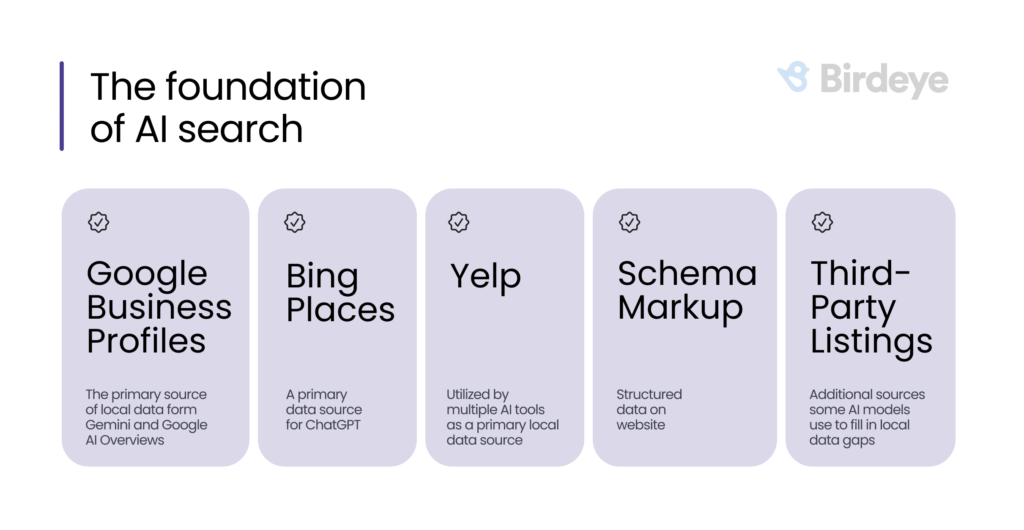
Practical tips to get your business ranked in AI search results
Understanding how AI interprets local signals is one thing. Executing a strategy that ensures your business surfaces in AI-driven discovery is another. Here’s what businesses should prioritize to stay discoverable—and trusted—as AI search evolves:
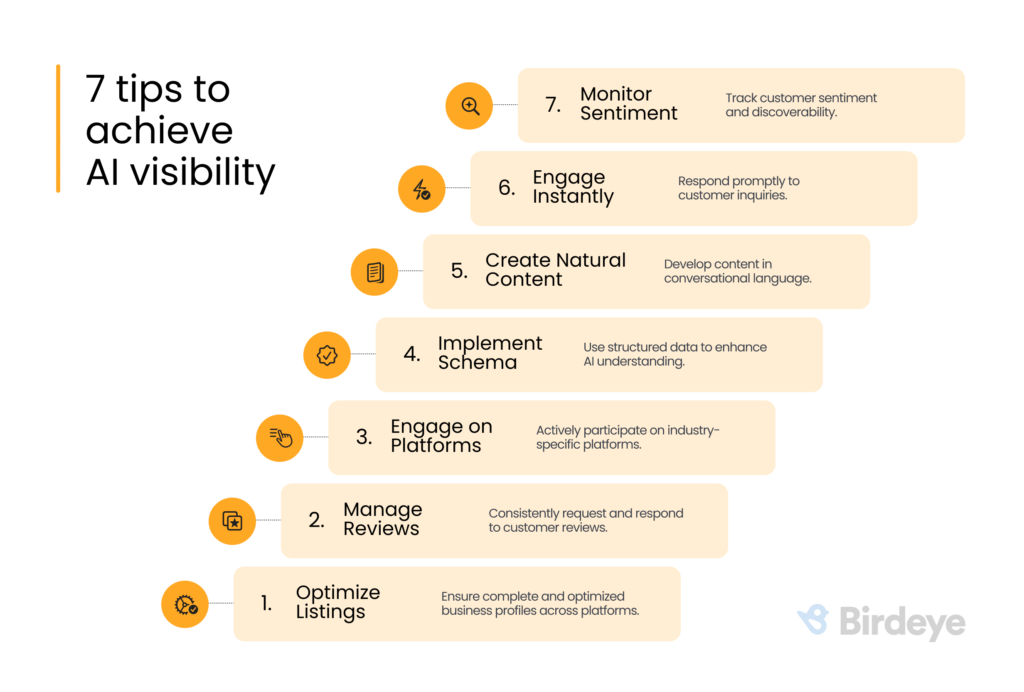
1. Complete and optimize your Google Business Profile and Bing Places listings
Ensure consistency in your business’s name, address, phone number (NAP), and key service categories across all relevant platforms.
Solutions like Birdeye Listings AI centralize the management of your listings, ensuring consistency across directories so you don’t have to worry about manually updating each platform.
2. Be active on vertical-specific platforms
Industry-specific sites like TripAdvisor (hospitality), Healthgrades (healthcare), Avvo (legal), or Houzz (home services) carry major weight in AI trust models. A strong profile here reinforces your authority within your niche.
3. Create content in natural, conversational language
AI tools favor businesses whose websites and social presence reflect how real people speak and search. Use customer-friendly phrasing in service pages, FAQs, and blog content.
Birdeye Social AI generates localized, natural social posts at scale. This reinforces your brand voice across all digital touchpoints.
4. Request and respond to customer reviews consistently
Reviews are key signals for AI recommendations, but it’s not just about collecting reviews—it’s about engaging with them, monitoring sentiment, and acting on feedback, which are crucial for improving your AI visibility. AI increasingly “reads” customer feedback to assess quality and trustworthiness.
Birdeye Reviews AI automates review generation, monitors sentiment trends, and uses AI to craft thoughtful, brand-consistent responses at scale.
5. Engage instantly with prospects and customers
Messaging is increasingly a key discovery and engagement channel, especially when AI chatbots and virtual assistants direct customers to businesses.
Birdeye Messaging AI consolidates conversations across text, webchat, and social platforms—all in one place for faster responses.
6. Monitor your discoverability and customer sentiment across all channels
Staying visible in AI search isn’t just about optimizing once—it’s about consistently tracking how customers perceive your business.
Birdeye Insights AI gathers omnichannel data—across reviews, listings, surveys, and social—and surfaces insights on sentiment, reputation, and discoverability, giving businesses a clear playbook for improving their AI visibility over time.
7. Implement structured data on your website
Embed clear “LocalBusiness” and “Review” schema markup to help AI models extract the right details instantly. Structured data is becoming the shorthand AI uses to understand who you are and why you matter locally.
Businesses that treat AI readiness as an ongoing discipline, not a one-time project, will earn outsized visibility as AI-powered search evolves.
Getting found by AI search tools isn’t a future problem — it’s a present opportunity
Businesses that focus today on strengthening their online presence, managing customer sentiment, optimizing structured data, and engaging across digital touchpoints will be the ones AI consistently recognizes and recommends.
While AI may not fully “get” local today, it’s learning quickly.
Being discoverable isn’t just about ranking higher anymore.
It’s about making your business understandable, trustworthy, and easy to find. By building a resilient digital foundation now — and using the right tools, like Birdeye’s GenAI platform–to monitor, adapt, and scale, businesses can ensure they aren’t just participating in the AI evolution.
They’ll be leading it.
The question is: Will your business be ready to be found when it matters most?

Originally published
